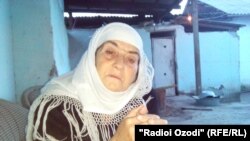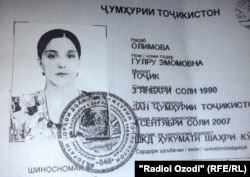When Gulru Olimova's husband, Loik, was killed fighting alongside Islamic State (IS) militants in Syria recently, the 25-year-old Tajik woman decided to pack her bags and return to Tajikistan with her children.
Following protocol, Gulru asked IS's amir, or commander, in Aleppo for permission to return home to Tajikistan.
The IS commander agreed to let Gulru leave. On one condition: Gulru's children -- 7-year-old Fotima, 4-year-old Ahmad, and 6-month-old Rumaiso -- were the "property of Islamic State," the commander said, and so she would have to leave them behind.
Back in Tajikistan, Gulru's 65-year-old mother, Mayrambi Olimova, is upset. She says Gulru won't leave Syria without her children.
Ever since January, when she found out Gulru was in Syria, Olimova has been urging her daughter to come home. At one point, in February, Olimova even make an impassioned video plea to IS leader Abu Bakr al-Baghdadi, begging him to make Gulru return.
But all that was before Loik was killed.
Olimova told RFE/RL's Tajik Service, Radio Ozodi, what happened when Gulru telephoned home to announce the 32-year-old Loik's "martyrdom," the term used by IS to describe death in battle.
"My daughter told me Loik had become a martyr and I said, 'Who knows if he became a martyr? He's gone and left his three kids, and his wife who's pregnant with number four, in mortal danger,'" Olimova said on May 11.
Gulru phoned home three times in all, telling her mother that she would not be in touch for another four months. According to Islamic law, she had to spend that time in mourning for Loik, her "martyr" husband.
"She asked for help to bring her three kids back to the motherland, because she won't budge from there without them," Olimova added.
From Tajikistan To Syria
Gulru told her mother that she currently lives in a three-story apartment building in a town in Syria's Aleppo province, near the Turkish border.
But Gulru grew up almost 3,000 kilometers away in the town of Kulob in southwestern Tajikistan.
As a child, Gulru wanted to be a nurse or maybe even a doctor, her mother told the Russian-language Meduza news site last month.
But those dreams seemed to have ended when Gulru was 16. That's when she met Loik Radzhabov, who Olimova claims was a "local drug dealer."
Loik asked for Gulru's hand in marriage but she refused, according to Olimova, who was also against the match. But the wedding went ahead anyway, after Loik threatened to "bury everyone" if Olimova refused to allow her daughter to marry him.
It seems Loik was radicalized in Moscow, where he traveled regularly on business. After one trip, Olimova says a black IS flag appeared in the couple's home.
In September 2014, Loik took his wife and children with him to Moscow, where he had reportedly found work on a construction crew, building dachas, Russian country homes, in the city's suburbs.
But Loik did not keep his family in Moscow for long. He and his family left for Syria in November, according to Radio Ozodi. Some reports say that Loik went to Syria with 25 other militants, including several Tajiks who have since been killed.
Olimova said that she found out that the family was in Syria in January, when she got a phone call from Loik. Her son-in-law announced that he had taken his wife and children to Syria and said Olimova should keep quiet about it.
Olimova told Radio Ozodi in February that she had not approached the law-enforcement authorities in Kulob to tell them about her daughter.
But it seems that Olimova's silence did not last long. In April, Olimova told Meduza that she had approached the local branch of Tajikistan's State Security Committee (GKNB), where she had worked for 31 years as a cleaner, and spilled the beans about Loik.
"Mostly I want them to bring Loik here, dump 10 liters of gas on his head and set fire to him," Olimova admitted to Meduza.
Apartment In Aleppo
Loik was still alive in early April when Gulru phoned her mother to say that the family had moved to an apartment block in the Aleppo suburbs. IS gave them $30,000 to move, she claimed. IS also gave the couple a "child-benefit" payment of $35 a month for each of their three children, Olimova told Meduza.
The new place had a TV, a refrigerator, and even a carpet.
But the best thing was that Loik would hardly ever need to fight in battles, Gulru reportedly told her mother.
Instead, Loik would work as a sort of guard, stopping cars and searching them for cigarettes and alcohol, both banned under IS's strict interpretation of Shari'a law.
Tajik militants are known to have carried out such "highway patrol" work in Iraq. A militant known as Abu Umariyon appeared on a video in January in which he says his job was to inspect cars for cigarettes and alcohol, and check that women are clad in hijabs, the approved Islamic clothing for women.
How And Where Did Loik Die?
Loik does not appear to have had any combat experience before joining IS in Syria.
According to a recent IS e-book, new recruits are put through basic training in an IS boot camp, though there is no confirmation that Loik went through such a camp. Even if Loik did pass IS basic training, it would not equip him for front-line fighting.
It was Loik's lack of battle experience that got him posted to the "highway patrol" job, but it is also the most likely reason that he was killed after just a few short months in Syria and Iraq.
The exact circumstances of Loik's death -- when it happened exactly, and where -- remain unclear. But over the past weeks there have been a number of offensives in which Russian-speaking and Central Asian militants are known to have fought and died.
It is possible that Loik may have been killed in Baiji in Iraq, where social-media reports suggest that IS sent a large force, including militants who did not usually fight on the front lines. At least two Chechen militants whose roles in IS were not front-line fighters were killed in the Baiji offensive within the same time frame that Loik was reported killed.
There is also evidence that in late April around the time that Loik must have been killed, Russian-speaking militants were sent to fight (and die) in Iraq's Anbar province.
A video shared this week by North Caucasian IS militants shows a group of Russian-speaking fighters undertaking a "bay'at al-mawat" (a pledge to fight to the death) before being sent out to fight in an offensive at Lake Tharthar in western Iraq. That offensive took place on April 25.
Only A Black Flag Remains
Back home in Kulob, Loik's death remains a tragic mystery.
Loik's father, Sherafgan Radzhabov, says he found out about his son's death from his daughter-in-law, Gulru.
The Kulob law-enforcement authorities say that they have only heard about Loik's death from his family. There has been no official word.
The only memento of Loik in Kulob is a black IS flag that law-enforcement sources say they found in his father's house. Loik's relatives say that it was Loik himself who hung the flag up before he disappeared.
Gulru's case is not the first in which IS's leadership has blocked family members of a dead militant from going home.
In 2013, IS's military commander in Syria, Umar al-Shishani, caused a controversy when he refused to allow the daughter of Chechnya's migration service to return home with her brother after her Chechen militant husband had been killed.
In that case, the widow herself said that she did not want to leave Syria, even though her father insisted that she should. Umar was criticized by an Islamic scholar, for overriding the woman's father.
However, Gulru's situation is the first reported case in which IS has insisted on maintaining "possession" of a dead militant's children against the wishes of the child's mother.
Tajiks In IS
It is not known exactly how many Tajiks are fighting in Syria and Iraq alongside IS.
Official data puts the figure at 300 Tajiks, of whom 60 have been killed.
Edward Lemon of the University of Exeter in the United Kingdom, who tracks Tajik militants, says that he has a list of 102 Tajiks fighting in Syria and Iraq. However, Lemon says that the figure, which is based on officials, media reports, and videos, should be taken with caution, because there are likely to be more Tajiks fighting in Syria than have been reported.
The figure of 102 Tajiks does not include Colonel Gulmurod Halimov, an OMON (Special Purpose Police Unit) commander, who unconfirmed Tajik reports have claimed departed to fight in Syria, together with a group of 10 other Tajiks.
The authorities in Tajikistan's Khatlon district, where Kulob lies, have opened 40 criminal cases against individuals -- including Loik -- who are suspected of taking part in military activities overseas.
-- Joanna Paraszczuk









